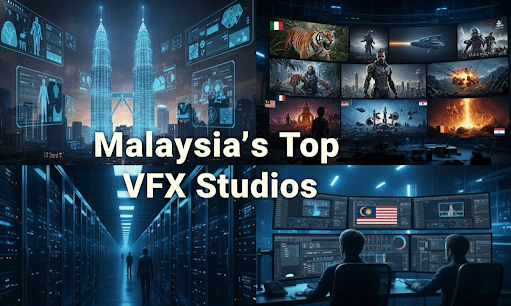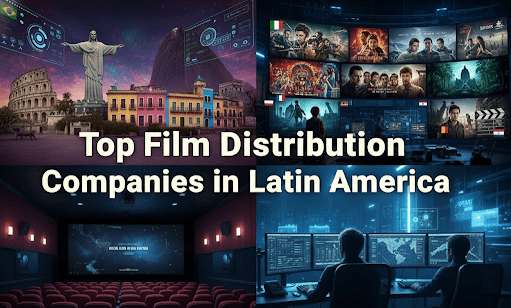Europe’s Top VFX Studios [2025 Power List]
![Europe's Top VFX Studios [2025 Power List] 2 Europe's Top VFX Studios](https://vitrina.ai/wp-content/uploads/2025/10/Europes-Top-VFX-Studios-e1760432117570.webp)
Introduction
The landscape of content creation has been irrevocably altered by the constant, escalating demand for world-class visual effects (VFX). For senior executives overseeing film slates, high-end television, and international co-productions, selecting a VFX partner is no longer a simple transactional decision—it is a strategic choice that dictates budgetary efficiency, final creative quality, and delivery timelines.
The European market, in particular, has emerged as a global center of excellence, driven by highly skilled talent pools and aggressive governmental incentives.
The sheer volume of content—from blockbuster feature films to high-budget episodic series—requires a global and agile sourcing strategy. Identifying the right partner from the multitude of qualified vendors is a complex challenge, but crucial to securing both artistic excellence and financial viability.
This report provides a strategic look at the factors shaping the European VFX market in 2025 and profiles a curated list of companies, helping you identify Europe’s Top VFX Studios and the specific capabilities they bring to global content supply chains.
Table of content
- Setting the Stage: The Strategic Value of European VFX Hubs
- Our Evaluation Framework: Vetting the Best VFX Studios in Europe
- The Top VFX Studios in Europe: 2025 Power List
- How to Integrate These Partners into Your Production Pipeline
- How Vitrina Helps: De-Risk Your VFX Sourcing and Co-productions
- Conclusion: Strategic Sourcing for European VFX Excellence
- Frequently Asked Questions
Key Takeaways
| Category | Description |
|---|---|
| Core Challenge | Finding world-class VFX partners that align with project scale, creative requirements, and complex co-production or tax incentive criteria. |
| Strategic Solution | Adopting a data-centric sourcing process to vet companies based on verified track record, technical specialty, and financial stability. |
| Vitrina’s Role | Providing the verified intelligence layer to track projects, profile vendor specialization, and vet decision-makers across the global entertainment supply chain. |
Setting the Stage: The Strategic Value of European VFX Hubs
The European VFX market is not merely a collection of vendors; it is a global competitor that captured approximately 22% of the world’s output in 2024, according to a recent market report. This growth is centered around highly incentivized creative hubs like the U.K., France, and Germany, making a partnership with Europe’s Top VFX Studios a cornerstone of global production strategy.
A major driver for this strategic shift is the increasing generosity and specificity of tax incentives. The U.K., a primary hub, has solidified its position with the new Audio Visual Expenditure Credit (AVEC) regime. Effective from April 2025, qualifying U.K. VFX costs for film and high-end TV benefit from an overall net tax relief rate of 29.25%, with the previous 80% cap on qualifying expenditure specifically removed for these costs, according to the British Film Commission. This is a direct incentive for international productions to spend more of their visual effects budget within the U.K.
Similarly, France’s Tax Rebate for International Productions (TRIP) offers a substantial 30% rebate on eligible French expenditures, which can increase to 40% if the French VFX expenses exceed €2 million, as noted by Film France CNC. These financial advantages are now so deeply integrated into production budgeting that the choice of a VFX partner directly impacts a project’s financing structure.
Beyond financial incentives, the market is characterized by rapid technological adoption. Trends in 2025 show that real-time VFX and virtual production (VP) are becoming standard practice, with 40% of the market reporting a rise in virtual production adoption, according to Global Growth Insights. Studios are also leveraging Artificial Intelligence (AI) to accelerate workflow, with some studios reporting up to 60% production cost savings on routine tasks like rotoscope and cleanup via AI tools.
This blend of financial advantages and technical sophistication is what makes Europe’s Top VFX Studios indispensable partners for modern, high-volume, and high-quality content pipelines.
Our Evaluation Framework: Vetting the Best VFX Studios in Europe
Selecting a VFX partner requires moving beyond portfolio highlights and applying a rigorous, data-driven framework. The studios on any executive’s shortlist must be evaluated against criteria that reflect both creative excellence and operational reliability. When assessing Europe’s Top VFX Studios, I prioritize four non-negotiable pillars:
- Creative and Technical Specialization: It is crucial to look past generic “VFX” services and verify a studio’s mastery in specific areas. This includes proprietary tools (e.g., custom fluid simulation software), established expertise in photorealistic creatures and digital humans, or a proven track record in high-volume episodic VFX, which requires a fundamentally different pipeline than feature film work.
- Scale and Pipeline Agility: A studio’s true capacity is measured by its ability to scale up or down rapidly to meet the demands of a streaming service’s series or a tentpole feature film. This involves assessing their distributed, cloud-ready pipelines and their ability to operate across multiple time zones—a non-negotiable factor when managing cross-border European co-productions.
- Financial and Co-production Compliance: In Europe, financial stability is linked to regional incentives. A top-tier studio must not only be financially sound but must also possess expertise in navigating the complexities of European co-production treaties, cultural tests, and maximizing tax rebate schemes like the U.K.’s AVEC or France’s TRIP for their clients.
- Verified Track Record and Reputation: The focus must be on verifiable project delivery, not promotional claims. A strong partner demonstrates a clear history of on-time, in-scope delivery for high-profile clients in the specific format required (e.g., feature film vs. HETV).
By applying this executive-level framework, you can move past anecdotal evidence and secure a partner that mitigates financial risk while guaranteeing creative quality.
The Top VFX Studios in Europe: 2025 Power List
This curated list of Europe’s Top VFX Studios highlights key players across the continent, focusing on studios that demonstrate a capacity for high-end visual effects, often specialized for regional co-productions or specific technical services. The list is presented in the order provided, ensuring an objective review of the companies identified by our intelligence platform.
- Genesis Animation VFX Studios
The studio is a known provider of VFX and animation services, typically servicing feature films and episodic content, with an emphasis on creating detailed character animation and digital environments. - Top Film CIS
Specializing in the Commonwealth of Independent States (CIS) region, this studio focuses on production services, including a significant VFX and post-production offering tailored for high-volume regional content and international co-productions seeking regional expertise. - Top Kids
Primarily an animation house, this company brings a specialization in children’s television and animated features, requiring clean, stylized, and often complex 2D and 3D visual effects for narrative storytelling. - Top Film Baltic
This studio offers comprehensive film and television services across the Baltic States, including full post-production and VFX packages, often functioning as a key regional partner for larger international projects leveraging local incentives. - CineLab VFX
A provider of high-fidelity visual effects, CineLab VFX is known for its work on complex digital compositing, set extension, and environment creation for large-scale dramatic and action-oriented productions. - Toptop Films
Operating as a full-service production entity, Toptop Films integrates post-production and visual effects deeply into its pipeline, ensuring a unified creative and technical approach from pre-production through final delivery. - Automatik VFX
Focused on the technical execution of visual effects, Automatik VFX offers high-end digital services, specializing in procedural generation, complex simulation effects, and clean-up for both episodic and feature-length content. - Trimaran VFX
This studio brings creative expertise to the compositing and matte painting phases of VFX, often specializing in creating vast, realistic digital backgrounds and seamlessly integrating live-action plates with CGI elements. - TOP The Oligarchs Productions
A film and television production group with in-house post-production capabilities, the company leverages its integrated model to offer cost-efficient, high-quality VFX solutions for its own slate and select co-productions. - Victorine Studios
Located in France, Victorine Studios draws on the country’s rich cinematic history, offering a blend of physical production support and high-end digital post-production and VFX services, well-positioned to access the French TRIP incentive.
How to Integrate These Partners into Your Production Pipeline
Engaging one of Europe’s Top VFX Studios requires a disciplined, multi-stage integration strategy that moves beyond traditional vendor management. Your primary goal is to establish a unified pipeline that capitalizes on a studio’s technical strengths while maximizing regional financial advantages.
- Align Sourcing with Tax Incentives: Before issuing a Request for Proposal (RFP), your finance and legal teams must work with the production services division to match the project’s specific budget needs with a country’s incentive structure. For example, if your VFX needs are large-scale, targeting a studio in the U.K. (to capitalize on the uncapped VFX element of the AVEC) or France (to hit the €2 million threshold for the 40% TRIP bonus) becomes a financial imperative. The services partner you select must be an experienced applicant and administrator of these complex schemes.
- Standardize Technical Vetting: The RFP should mandate detailed responses on technical capability, not just creative samples. Specifically, demand information on:
- Pipeline Interoperability: Can they integrate their workflow with your cloud-based asset management and editorial systems (e.g., ShotGrid)?
- Virtual Production Expertise: What is their experience with LED stages, in-camera VFX, and Unreal Engine integration? This capability is critical for accelerating the demanding episodic TV slate.
- AI/Machine Learning Integration: How are they using AI to automate low-value tasks like roto or plate cleanup, and how does this translate to lower bid costs or accelerated delivery for your project?
- Establish a Data-Driven SLA: Service Level Agreements (SLAs) must be tied to verified delivery metrics, not just subjective quality assessments. Use data from their prior projects to set benchmarks for shot completion rates, revision cycles, and final delivery dates. This data-first approach, which tracks a partner’s true delivery performance across multiple projects, de-risks the entire post-production process.
By framing the selection of one of Europe’s Top VFX Studios as a strategic decision—driven by incentives, technical rigor, and verifiable performance—you transform the partnership from a service contract into a crucial element of your content financing and delivery success.
How Vitrina Helps: De-Risk Your VFX Sourcing and Co-productions
The core challenge in sourcing services from Europe’s Top VFX Studios is fragmentation: reliable data on vendor specialization, project history, and executive movement is scattered and often unverified. Vitrina solves this by acting as the centralized intelligence layer for the global entertainment supply chain.
Vitrina provides the verified data needed for a strategic selection. Executives can instantly search for studios based on verified specializations—filtering for expertise in digital creatures, high-end episodic TV, or virtual production, rather than relying on marketing claims.
Furthermore, the platform’s Project Tracker allows for competitive intelligence, revealing which top studios are being hired by rival companies for specific genres and budget tiers, providing a necessary, data-backed signal for partner evaluation.
By using Vitrina’s intelligence, you ensure that every partnership decision is grounded in verifiable company credentials and a proven delivery track record, dramatically improving the predictability and success of your high-stakes content investments.
Conclusion: Strategic Sourcing for European VFX Excellence
The European visual effects market is defined by creative mastery and competitive financial mechanisms. From the deep incentives of the U.K.’s AVEC to the technical leadership in virtual production across the continent, Europe’s Top VFX Studios offer compelling solutions for global content creators.
For the senior executive, success in this environment depends on a clear shift from reactive vendor selection to proactive, data-driven sourcing. By adopting a framework that systematically evaluates creative specialization, pipeline agility, and financial compliance, you can secure partners that enhance both the artistic vision and the commercial viability of your largest projects.
Frequently Asked Questions
The U.K. offers the Audio Visual Expenditure Credit (AVEC), which provides a net tax relief rate of 29.25% for qualifying VFX costs, notably removing the 80% cap on expenditure for these costs. France offers the Tax Rebate for International Productions (TRIP), which can reach a 40% rebate on all eligible expenses if French VFX spend exceeds €2 million.
The European VFX market holds approximately 22% of the global market share and is projected for strong growth. One industry report valued the global VFX market at $5.49 billion in 2025, with Europe contributing significantly, driven by subsidies and a skilled labor pool, according to Global Growth Insights.
The highest concentration of top-tier VFX studios is in London, which remains a key global hub. Other major centers include Paris, which is strong in commercial post and art direction, and Munich and Berlin in Germany, which benefit from robust co-production incentives.
Major trends include the accelerated adoption of real-time VFX and virtual production, with a significant rise in the use of LED walls and Unreal Engine integration for in-camera visual effects. Additionally, studios are increasingly implementing AI and machine learning tools to automate routine tasks, which cuts costs and speeds up the delivery pipeline.





























![The UK's Top VFX Companies [2025 Guide] 14 UK's Top VFX Companies](https://vitrina.ai/wp-content/uploads/2025/10/UKs-Top-VFX-Companies-e1760438286680.png)

![South Korea's Top VFX Companies [2025 Guide for Executive Partner Sourcing] 16 South Korea's Top VFX Companies](https://vitrina.ai/wp-content/uploads/2025/10/South-Koreas-Top-VFX-Companies-e1760432056369.webp)